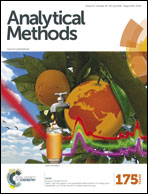Determination of the geographical origin and ethanol content of Brazilian sugarcane spirit using near-infrared spectroscopy coupled with discriminant analysis†
Abstract
Aguardente is a typical Brazilian spirit produced by the distillation of sugarcane. The valorisation of this spirit can be attributed to its notoriety, related to its production origin which can influence its quality. Therefore, the objective of this study was to use NIR spectroscopy coupled with discriminant analysis as a non-destructive method to validate the authenticity of aguardentes produced in two geographic regions and to predict their ethanol content. Some chemometric methods were used to discriminate the sugarcane aguardente, namely partial least squares-linear discriminant analysis (PLS-LDA), principal component analysis-linear discriminant analysis (PCA-LDA), and variable selection techniques such as successive projection algorithm (SPA-LDA) and genetic algorithm (GA-LDA). NIR spectra were collected using a FT-NIR spectrometer (4000–10 000 cm−1) with a spectral resolution of 16 cm−1, 8 cm−1 intervals, and 64 scans. The PCA results were not effective in classifying the aguardente samples, but with PLS-DA, PCA-LDA, SPA-LDA, GA-LDA and LDA it was possible to obtain an 87.2% prediction accuracy. Better results were obtained using PLS-DA on raw spectra and GA-LDA using only six wavelengths (namely 1025 nm, 1181 nm, 1596 nm, 1610 nm, 1653 nm, 2125 nm) which gave a relatively good accuracy rate (up to 87.2%). NIR spectroscopy and chemometrics can be used as a non-destructive method to validate authenticity, and PLSR combined with NIR was a good non-destructive method to predict ethanol content in sugarcane aguardente.


 Please wait while we load your content...
Please wait while we load your content...